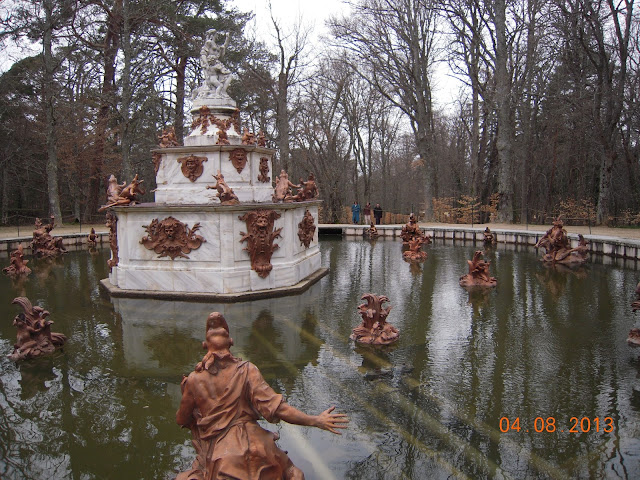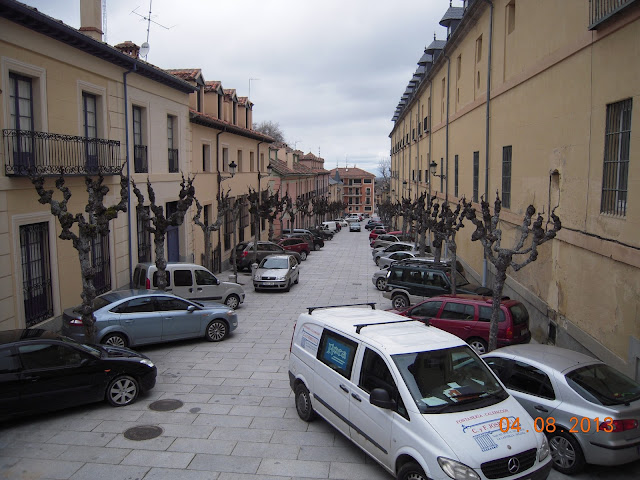Our trip last Tuesday with Paco and Suzi Serrano to La Granja and Segovia was so amazing, and I took so many pictures that I've decided to break it into 2 postings. Otherwise the size of the posting would probably discourage all but the most loyal of readers to skip over it.
The Royal Palace of La Granja de San Ildefonso (Spanish: Palacio Real de La Granja de San Ildefonso) is an 18th century palace in the small town of San Ildefonso in the hills near Segovia, 80 km north of Madrid, central Spain, formerly the summer residence of the Kings of Spain since the reign of Philip V.
Due to their location on the forested northern slopes of the Sierra de Guadarrama, these were favorite hunting grounds for many Castilian kings. In the 15th century, Henry IV of Castile built the first hunting lodge on the site, along with a small shrine dedicated to San Ildefonso (Saint Ildefonsus), which gave this place its first name.
Isabella I of Castile granted both buildings to the monks of the Parral monastery in Segovia, who built a granja (farm) and an almshouse alongside.
The site was purchased from the monks in 1719 by Philip V, after his summer palace nearby at Valsaín burned to a shell. Beginning in 1721, Philip began building a new palace and gardens modelled on Versailles, built by his grandfather, Louis XIV of France. Like Versailles it embraced a cour d'honneur on the approaching side, and formal gardens, with a main axis centered on the palace, that were surrounded by woodland in which further hidden garden features were disposed. Like Versailles, La Granja began as a retreat from the court but became a center of royal government. The gardens are replete with fountains and hidden retreats covering over 1500 acres.
Pictures of the countryside on the way to La Granja. It has been a cold, wet spring so the landscape is not as lush and green as it will be in another 2-3 weeks. That is very apparent on the grounds of the palace and in the gardens. In fact, they don't turn on the fountains throughout the gardens and park until after the 1st of May. But the benefit of going now is there were no crowds, a wonderful blessing.
A spillway from the damned lake. There has been so much rain and snow in the mountains that they are releasing water to avoid later flooding.
 |
| La Granja straight ahead at the foot of the mountains |
Approaching the palace and gardens from the village
Parking just outside the Palace. The streets and architecture were unusual.
Notice the trees, though not yet in bloom.
Looking back at the village from the Palace entrance.
The largest tree I can remember seeing, having never seen the Redwoods in California.
This tree was huge, located just outside the entrance to the Palace.
Entrance to the Palace fromt the village.
Vivienne, Paco and Suzi. I should explain our dress: It was our personal "P-day".
The street lamps were charming.
This looks like the Whomping Willow of Hogwarts.
Entrance to the gardens of the Palace
Inside the Gardens entrance looking at the side of the palace, the so-called "Horseshoe".
Actually the back of the palace, inside the gardens, is the most striking view of the palace itself.
Another side view
The start of the gardens on one side of the palace.
At the end of this manicured section at the end of the road, in the distance you can see the fountain of fame, or Fuente de la Fama pictured below.
Keeping in mind the fact that this palace, including the gardens, statuary and fountains are older than the birth of our country, they are truly amazing.
Unfortunately you can only appreciate the splendor of this single fountain by standing at its edge.
The photo does not show the fine detail of the figures.
Looking back from the Fuente de la Fama to the Palace
About 1/2 mile away up one of the many other roads, or "calles" was this fountain, the plaza of the baths of Diana, of Greek mythology.
There were thousands of large sea shells in the facade of the fountain.
All over the grounds are hundreds of pieces of beautiful marble statuary mounted on heightened pedestals.
The next one we discovered was The Fountain of Frogs, or Fuente de las Ranas, depicting the metamorphic turning of frogs into men, or vice-versa.
I wasn't sure.
The figures were 1/2 man and 1/2 frog. None of the fountains were operating; they turn them on when May arrives, but you can imagine what these would look like.
Notice the large underwater piping to produce the huge eruptions of water out of each of the figures, and then contemplate how this was possible to achieve in an era before electricity to run the pumps that now do the work.
Calle Larga, or "long road" led to a large crossroads.
In the photos immediately below I captured the view of these roads, each of which led to many other fountains, benches and statuary.
Looking at the back of the palace from the crossroads of Calle Larga.
When the pools and fountains are full, water cascades down over these marble steps.
At the base of the cascading marble steps is this pool featuring figures of Neptune, god of the oceans.
Neptune with his trident
Back at the palace gates looking down the village street to where the car was parked.
During the heat of summer thousands of people flock to this summer palace of the ancient kings and enjoy the parks and fountains and cool weather.
La Granja is fantastic.
And we didn't even tour inside the palace.
That will be another visit. Invitation to Michelle, Shakayla and Heather, and anyone else.
Come visit and we'll take you there!








































I love the fountains! Especially the sea shell one. Note for planning our trip: come in summer when the fountains are on.
ReplyDeleteYou can really tell that it was copied from Versailles - my mission was in France, so I've seen Versailles then and on a couple trips since. Another wonderful copy is at Peter the Great's palace outside St. Petersburg, Russia.
ReplyDelete